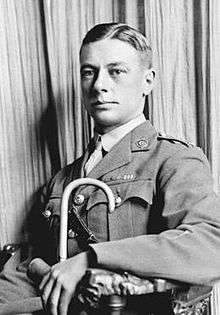George Mullin (VC)
George Harry Mullin VC, MM (15 August 1891 – 5 April 1963) was an American-Canadian soldier in the Canadian army. Mullin was a recipient of the Victoria Cross, the highest award for gallantry in the face of the enemy that can be awarded to British and Commonwealth forces.
George Mullin | |
|---|---|
 Lieutenant George Mullin c.1918 | |
| Nickname(s) | Harry |
| Born | 15 August 1891 Portland, Oregon, United States |
| Died | 5 April 1963 (aged 71) Regina, Saskatchewan, Canada |
| Buried | South Side Cemetery, Moosomin |
| Allegiance | |
| Service/ | Canadian Expeditionary Force |
| Rank | Major |
| Unit | Princess Patricia's Canadian Light Infantry |
| Battles/wars | First World War Second World War |
| Awards | Victoria Cross Military Medal Mentioned in Despatches |
| Other work |
|
Details
Mullun was born in Portland, Oregon, and his parents brought him to Moosomin, Saskatchewan at the age of two. He enlisted in the Army in December 1914.
Action
He was 26 years old, and a sergeant in Princess Patricia's Canadian Light Infantry, Canadian Expeditionary Force during the First World War when the following deed took place for which he was awarded the VC.
On 30 October 1917 at Passchendaele, Belgium, Sergeant Mullin single-handed captured a pill-box which had withstood heavy bombardment and was causing heavy casualties and holding up the attack. He rushed the snipers' post in front, destroyed the garrison with bombs, shot two gunners and then compelled the remaining 10 men to surrender. All the time rapid fire was directed on him and his clothes were riddled with bullets, but he never faltered in his purpose and he not only helped to save the situation but indirectly saved many lives.
Citation
The citation reads:
No. 51339 Sjt. George Harry Mullin, M.M., Can. Inf.
For most conspicuous bravery in attack, when single-handed he captured a commanding "Pill-box" which had withstood the heavy bombardment and was causing heavy casualties to our forces and holding up the attack. He rushed a sniper's post in front, destroyed the garrison with bombs, and, crawling on to the top of the "Pill-box," he shot the two machine-gunners with his revolver. Sjt. Mullin then rushed to another entrance and compelled the garrison of ten to surrender. His gallantry and fearlessness were witnessed by many, and, although rapid fire was directed upon him, and his clothes riddled by bullets, he never faltered in his purpose and he not only helped to save the situation, but also indirectly saved many lives.
Further Information
Mullin had earlier received the Military Medal [3] and finished the war as a lieutenant.[4] In 1934 he was appointed as Sergeant at Arms of the Saskatchewan legislature. Mullin served as a captain in the Veterans Guard during the Second World War. He was also a father of 4 and a loving husband.
Mullin is commemorated with the two-block long residential street 'Mullin Avenue' in the south central part of Regina, Saskatchewan.[5]
Mullin is buried at Moosomin South Side Cemetery, Moosomin, Saskatchewan, Canada in the Legion Plot (approximately N 50.13409 W 101.68206 ).
His Victoria Cross is displayed at the Museum of the Regiments in Calgary, Alberta, Canada.
References
- "No. 30471". The London Gazette (Supplement). 11 January 1918. p. 723.
- "No. 31259". The London Gazette (Supplement). 31 March 1919. p. 4160.
- "No. 29953". The London Gazette (Supplement). 19 February 1917. p. 1757.
- "No. 30861". The London Gazette (Supplement). 24 August 1918. p. 9893.
- "Archived copy". Archived from the original on 2016-08-21. Retrieved 2016-07-11.CS1 maint: archived copy as title (link)
Further reading
- Monuments to Courage (David Harvey, 1999)
- The Register of the Victoria Cross (This England, 1997)
- VCs of the First World War - Passchendaele 1917 (Stephen Snelling, 1998)
External links
- George Harry Mullin biography on DHH
- "George Mullin". Find a Grave. Retrieved 2009-02-22.